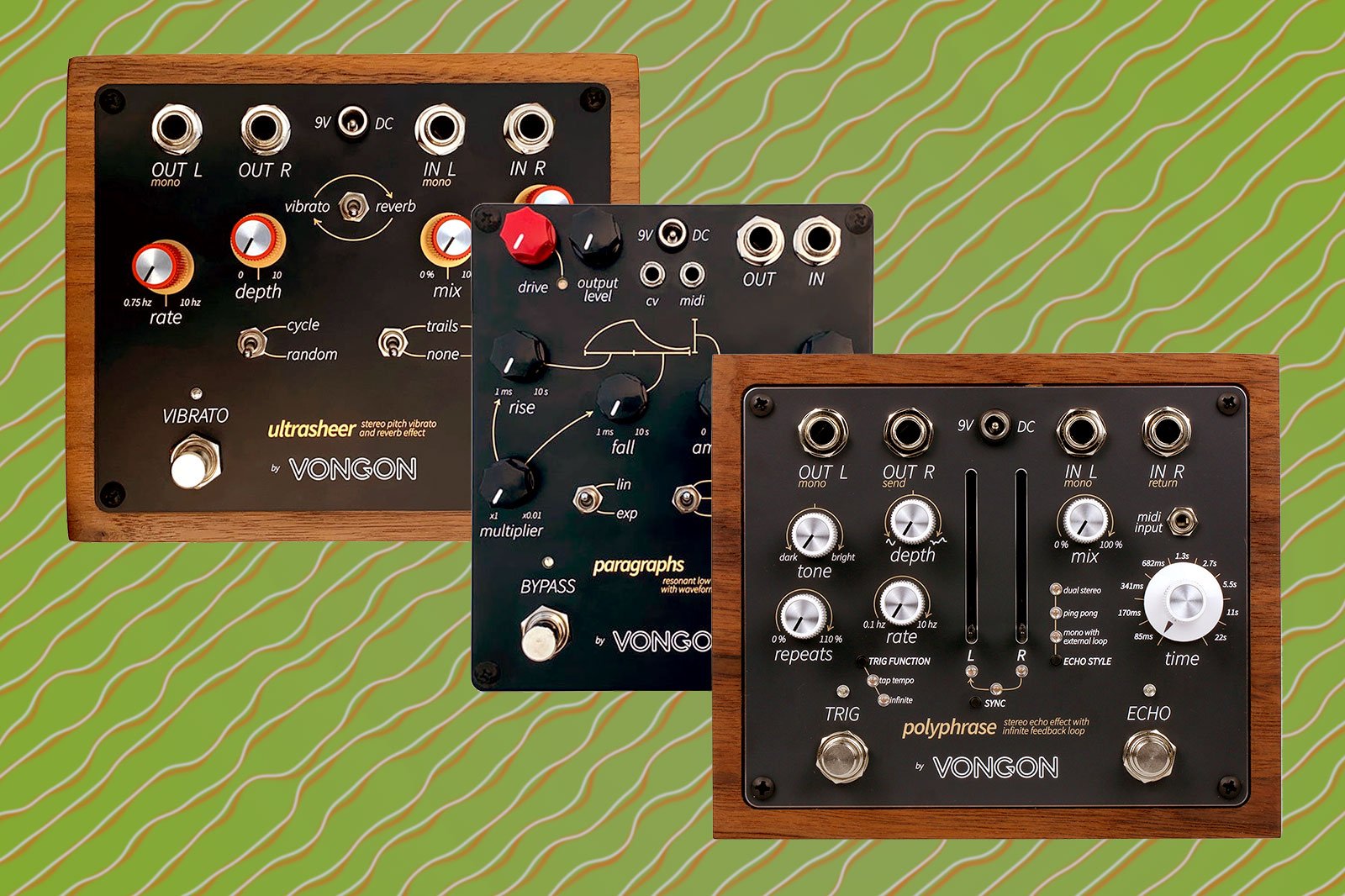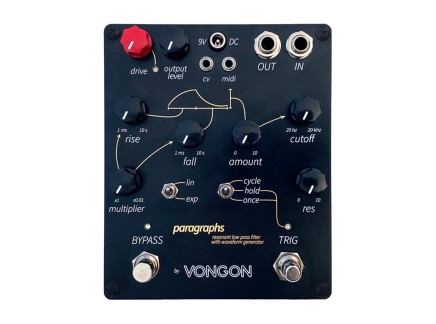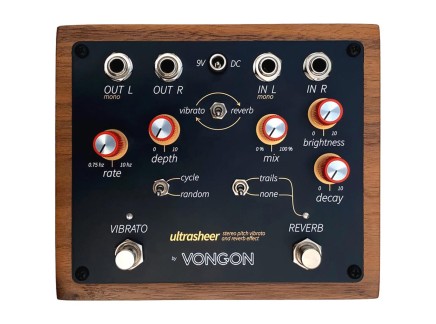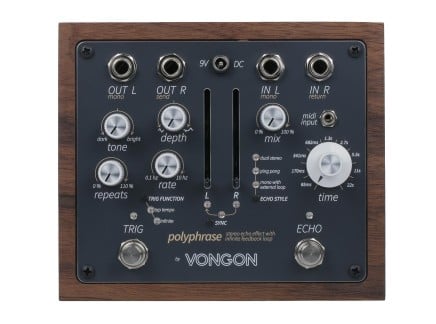In the past couple of years, the world of boutique effect pedals has been filled with creative new designers—colorful creators building unique devices for finessing, massaging, and outright transforming audio into something lush, beautiful, bizarre, or simply new. Unless you've been hiding under a rock, you've probably noticed Vongon recently rising to the top of the list of highly-favored boutique builders...but who is Vongon, and what are they all about?
Vongon is a small pedal manufacturer based in Oakland, CA, helmed by Ryan McGill. Though one of their first devices (the VF-104 MIDI controller/preset memory for the Moog MF-104M Analog Delay) made an appearance in 2019, Vongon really got off the ground in 2020 when they began introducing their own line of excellent-sounding effect pedals—all hand-made, with clear user interfaces and beautiful enclosures.
Vongon takes inspiration from vintage studio effect processing techniques and the world of synthesis, packaging specialized concepts from these distinct universes into effect pedals. And while their entire lineup works great with guitar or bass, they're all equally at home with synthesizers, drum machines, studio production setups, and more. If you're looking for forward-thinking effects with a touch of vintage flavor, they have a lot to offer. So, that said, let's take a look at their current pedal lineup: the Paragraphs filter + waveform generator, Ultrasheer vibrato + reverb, and the new Polyphrase stereo echo/looper.
Paragraphs: the Filter Effect Pedal You've Been Waiting For
Looking at Vongon's Paragraphs as if it were just another filter pedal would be a great disservice to not just the pedal itself—but to your own music. Paragraphs isn't a simple auto-wah or envelope filter: instead, it's a tool for adding some expressive, powerful synthesis tricks to your effect pedal arsenal.
The heart of Paragraphs is a four-pole resonant lowpass filter. This filter is based on the AS3320 chip—an accurate replica of a classic filter IC found in countless classic synthesizers and drum machines, from the LinnDrum to the Prophet-5, Pro One, and more. What does that mean? Well, unlike your average wah, this filter is optimized to sound much more like the lowpass filter in a synthesizer: it has a quite steep cutoff slope (24dB/octave), an uncommonly smooth cutoff sweep, and it'll self-oscillate at maxiumum resonance. Rather than simply being for Mu-Tron-like duck quacks, you can think of this as a general sound-sculpting tool. It's something more like a Moog MF-101—but much more affordable, and still in production.
Paragraphs is optimized to accept both instrument and line-level signals, so it's every bit as capable of handling electric guitar and bass as it is synthesizers and drum machines. The top left of the panel features two gain staging controls: an output level control, and a continuous drive control. The drive is an important feature of the design, offering enough gain to go from pure, clean input all the way to clipped fuzz tones. This is an important feature in a pedal where the filter imparts so much character: the ability to significantly overdrive the input gives the filter itself much more to bite into. The drive control offers a multi-color LED to give you an idea of just how much overloading you're adding.
Tasty filter and fuzz aside, the other thing that really sets Paragraphs apart from other filters is its built-in "waveform generator": a looping envelope which imparts modulation onto the filter's cutoff frequency. The waveform generator offers both linear and exponential shapes, and offers independent control of rise and fall times, giving you much greater flexibility than the average LFO-based auto-wah effect. Once you've dialed in the right shape with the rise and fall controls, the Multiplier knob acts as a timescale control for the envelope, allowing you to preserve the shape while altering the modulation frequency.
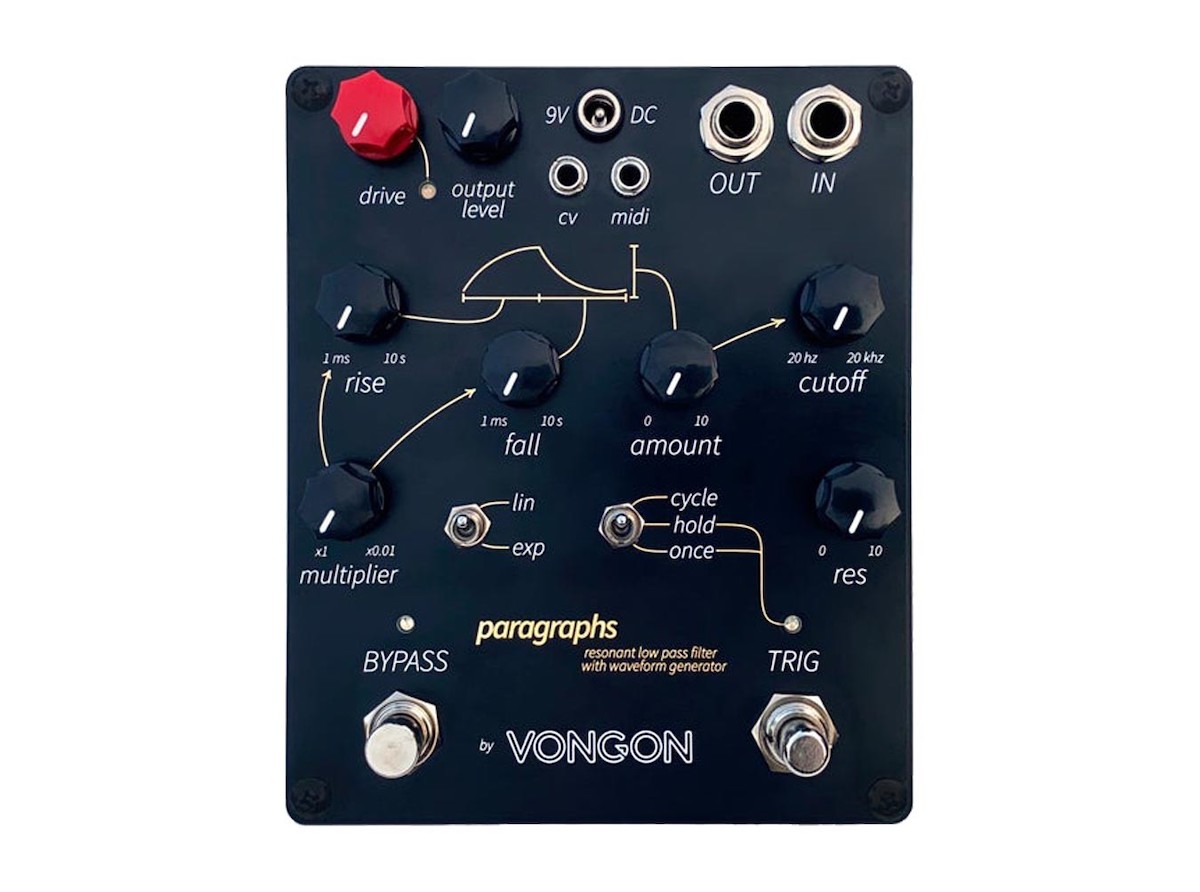
One of the most important aspects of Paragraphs is about just how fast the waveform generator can run. Most auto-wah pedals stop at relatively low LFO rates, but on Paragraphs, the rise and fall times range from 10 seconds all the way down to one millisecond—meaning that when looping, the envelope can run at hundreds of cycles per second, turning the Paragraphs into a means of intense audio-rate modulation, not unlike the sounds you'd get from extreme frequency modulation on a modular synthesizer, or from a characterful ring modulator. This is area largely unexplored by effect pedals in the past, and frankly, adding audio-rate filter frequency modulation to any pedalboard will take it into entirely new dimensions.
Of course, the envelope generator doesn't have to run in looping mode—it can also operate in a one-shot "once" mode or in an AR-envelope-like "hold mode." In these modes, it can be triggered using the built-in footswitch, and external trigger/gate from a modular or semi-modular synth, or even via MIDI note-on/off events.
Take all that and put it in a clean, clear, beautiful package, and you've got one of the most interesting filter pedals ever made. Clean filtering, gnarly fuzzy synth tones, and a self-oscillating filter with audio-rate modulation? Sign me up.
Ultrasheer: a Vintage Studio Reverb + Vibrato in a Pedal
If you were to compile a list of the most influential reverb processors ever created, the Lexicon 224 would almost certainly hold one of the top spots. Even though its 1978 release date makes it one of the earliest digital reverb designs, the 224 made the most of the technology that was available at the time. Despite its lower fidelity compared to today's top-of-the-line units, the sounds of the 224 continue to be highly sought-after because what it may lack in realism, it more than makes up for with its incredibly lush and musical character. The 224 has appeared on countless records over the years, though the best representation of its atmospheric capabilities is heard in Vangelis's score for Blade Runner, in which generous amounts of long-decaying reverbs were applied to instruments like Yamaha's CS-80.
Vongon's Ultrasheer just so happens to be based on the Lexicon 224's plate reverb algorithms, but with the addition of a digital vibrato effect that may be placed before or after the reverb. One nice thing about the Ultrasheer is that both effects may be enabled independently of each other, but of course, the magical and warbly sounds that can be found by using the two together are where the Ultrasheer shines brightest.
On the reverb side, Vongon keeps things simple by offering just three controls, plus a Trails switch, to the user, though there are actually some neat interactions between parameters going on beneath the surface. Mix is probably the most straightforward of these controls, as it simply dials in the dry/wet blend of the reverb and unaffected signal. If you're using Ultrasheer in a linear signal path, you'll likely want some amount of dry signal to pass through, but within an effects loop of a mixer or an outboard send from your DAW, setting Mix to the max yields a fully wet signal. As for Trails mode, this allows for reverb tails to continue after the effect is bypassed, though this means that the dry signal will be passed through the digital converters, even when bypassed.
But it's the Brightness and Decay controls that work together to really define the character of the reverb, and modifying one will have a noticeable impact on the other. Ignoring the Brightness knob for a moment, Decay allows you to dial in the length of the Reverb tail, roughly ranging from 0.25 to 30 seconds. Once you start playing around with the Brightness control though, you'll notice that lower and darker settings will decrease the perceived Decay time. This is because rather than operating as a simple tone-style control on the input or output stages, Brightness affects a lowpass filter within the reverb's feedback loop, thus higher frequencies are rolled off as they recirculate through the effect. As such, this is great for maintaining the brightness and clarity of the dry signal while still being able to immerse it in rich reverberant space.
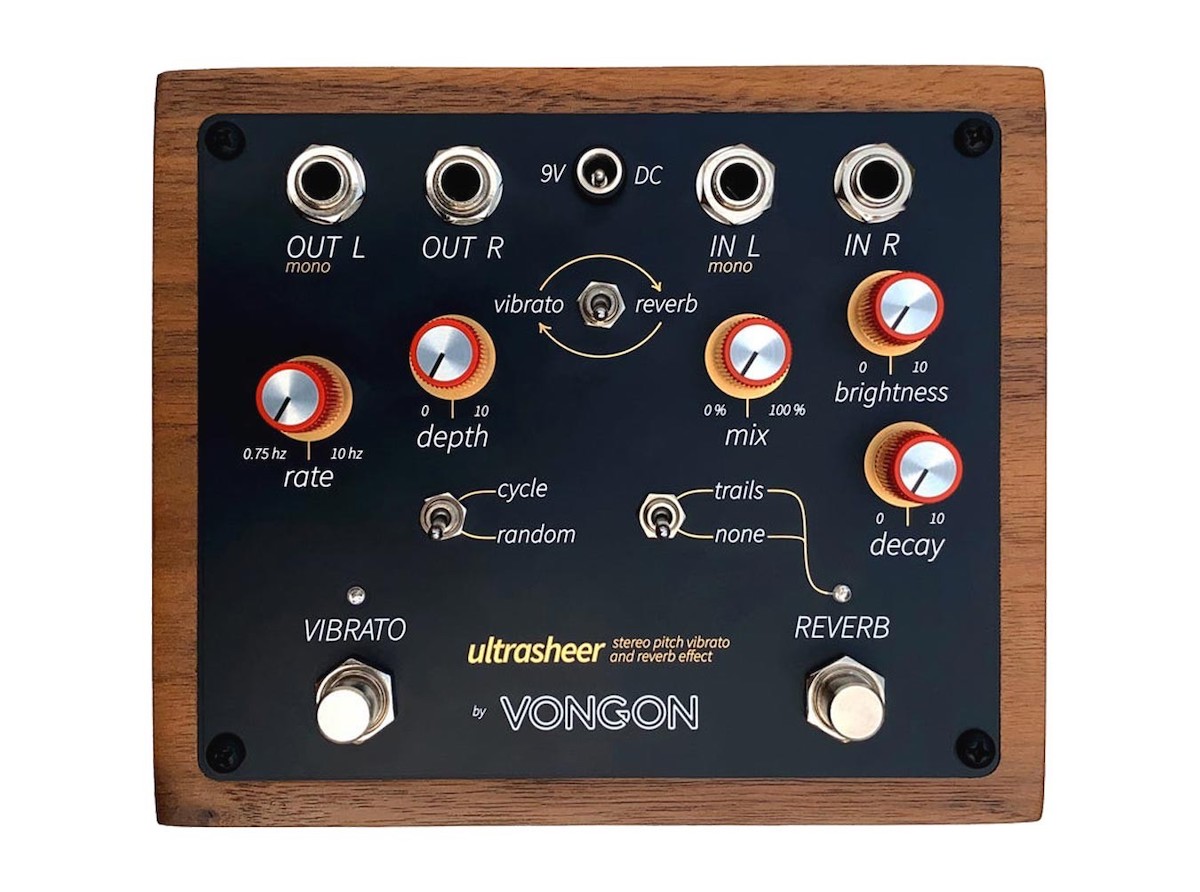
On the other side of the pedal are the controls for the vibrato effect, consisting of Rate and Depth controls plus a switch for Cycle and Random modes. In Cycle mode, you'll find more traditional vibrato sounds thanks to the continuous motion of a sine wave LFO, whereas Random mode uses a smoothed-out sample and hold to create tape-like wow and flutter effects. Vibrato frequencies range from 0.75 to 10 Hz, while Depth ranges from effectively bypassed to wild, seasick levels of pitch fluctuation. It's worth exploring the results to be had with the Effect Order switch because certain settings will have not-so-subtle differences between running the vibrato into the reverb, and vice versa.
Like the Lexicon 224 before it, we're amazed at how good the Ultrasheer sounds with literally any sound source. It's a stellar ambient effect for guitars and synthesizers, but dropping the Decay time to its minimum and cranking the Brightness setting can add some nice spattering textures to drums and percussion. Oh, and we should also mention how beautiful the solid walnut enclosure is—the Ultrasheer feels less like any old pedal and more like a nice family heirloom. So whether you're dropping the Ultrasheer onto your pedalboard or keeping it at your desk as an outboard effect, we're almost certain that it will be a go-to effect when luscious reverbs are in order.
Polyphrase: a Stereo Delay / Loop Experimentation Station
We talked about the Lexicon 224—but in the late 1970s, proto-delay rackmount units such as the Lexicon Prime Time were also becoming popular, finding their way into many studios. These early effects expanded producers' sonic territory, opening up the possibility for phrase looping, or freezing the delay's repeats. This could be used for both sound design and for compositional tricks, paving the way for the compact pedals and loopers we use today.
Vongon pays homage to these early delays with the gorgeous, easy-to-use Polyphrase stereo delay and phrase looper. Encased in a wooden enclosure similar to the Ultrasheer, the Polyphrase offers up to 22 seconds of delay time and the option for infinite repeats. The time can also go as fast as 85 milliseconds, which allows the Polyphrase to move into chorus/warble territory, largely due to the modulation section.
These details are what allow the Polyphrase to stand out amongst a crowded field of effects—the aforementioned modulation section gives you the option to adjust the depth and shape, moving from sine to a random waveform for different flavors. With the rate knob, you can dial in the perfect amount of subtle imperfections or wild pitch effects. However, you are not just limited to what you can do with the knobs, as an included MIDI input lets you automate control over both of these parameters for more experimental or rhythmic purposes.
Hard to miss, the center sliders are the stars of the Polyphase, providing you discrete control over both delay lines—in turn, allowing you to un-sync them and let them run free. This can help create a wide stereo field for unique interwoven tapestries. Used in conjunction with the Dual Stereo, Ping-Pong, and External Loop mode, the possibilities are vast. Dual Stereo mode will keep each delay line fixed to either the Left or Right output when running in stereo, or stack them together when in mono. Ping-Pong mode will have each delay line switch channels on the clock pulse when in stereo—or, in mono, it functions more like a multi-tap delay. The final mode turns the right channel into a send/return for the feedback path, letting you add effects into the chain for wild experimentation (try adding pitch shifters, frequency shifters, or phasers/other modulation effects for some truly wild sounds).
The true fun comes into the play with the footswitch-engageable infinite repeats option. When this is engaged, the delay line's contents are frozen, and you can adjust the feedback path (destructively) with the Time knob and sliders. In its simplest form, this frozen feedback can help to create rhythmic patterns, which could become the perfect basis for solo explorations. Alternatively, when MIDI sync'd, this could be a great heartbeat for group jams.
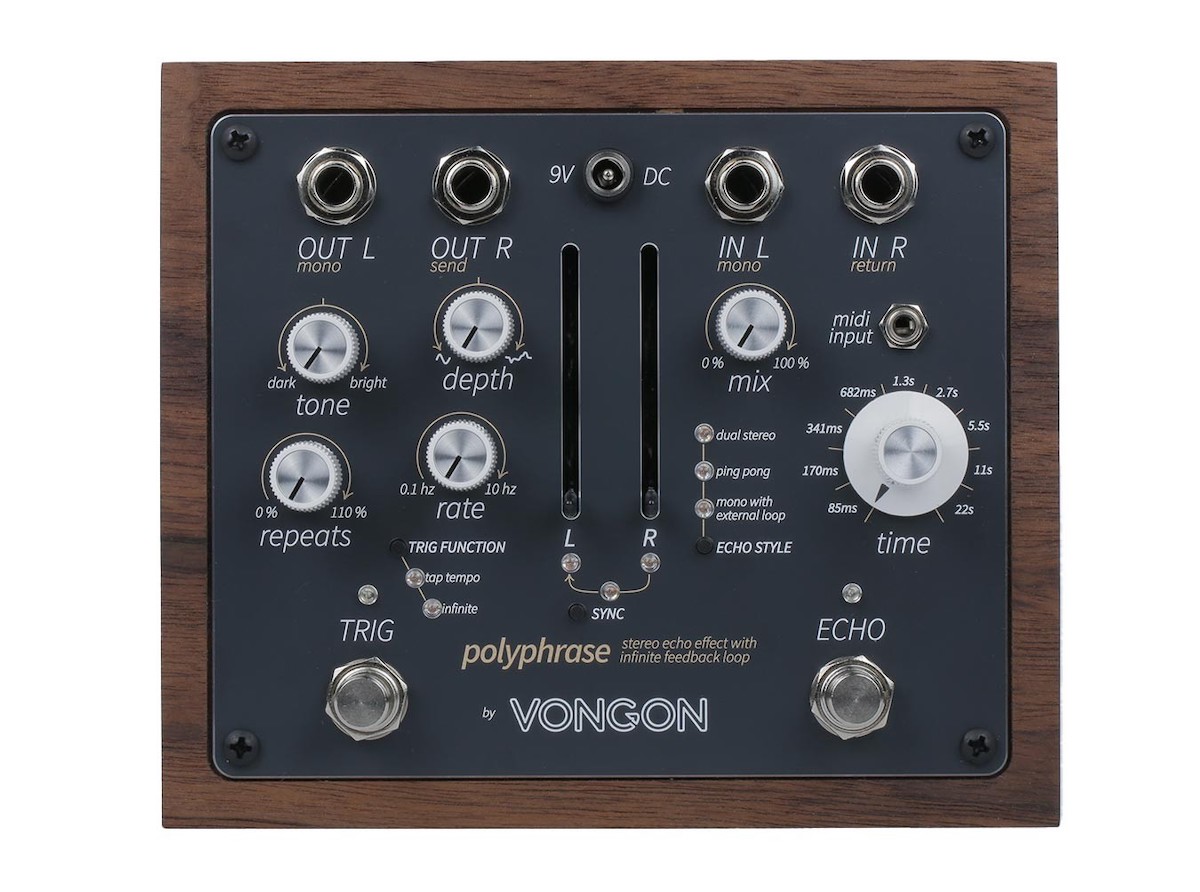
To push the envelope further, take a medium to long delay, and when you have a nice phrase locked in, start to play with the sliders. You can start to introduce delay artifacts into the mix which will stay locked in the loop. To customize this even further, you can start to adjust the delay time shorter to make more immediate rhythmic loops, but be careful: once you lose the longer loop, it's gone.
Vongon's Polyphrase is simple and fun to use either with a guitar, bass, keyboard, or as a desktop effect for studio usage. With a wide range of delay times, it makes this a powerful and versatile tool to have when crafting a sound. It functions beautifully in an experimental fashion, but can also be just a workhorse, daily-use delay—Polyphrase puts all the delay essentials into one very handsome package.
Vintage for the Future
Vongon has a knack for taking old concepts and shining a new light on them—presenting familiar ideas in such a way that you're inspired to use them for something completely new. You might not always think to use a filter for audio-rate modulation; and you might not think to use a dual delay for asychronous glitchy looping...but you can. And by surfacing specific features in the way that they do, Vongon makes it obvious that even a familiar effect can be used for as-of-yet unheard tricks.
New experimental techniques aside, it'd be hard not to recommend these pedals to anyone looking for an excellent-sounding filter, reverb, or delay. So whether you're trying to find some bread-and-butter effects to use in your everyday musicmaking or looking for something you can push into new sonic turf, you'll be well served by everything they have to offer.

